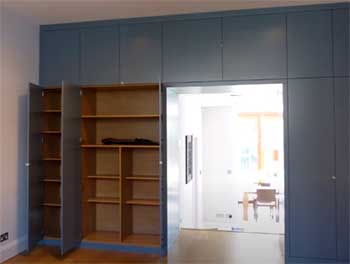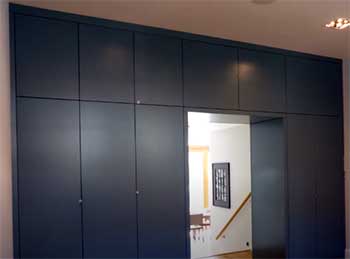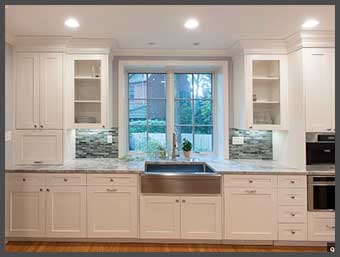Kitchen cabinets come in all shapes, sizes, and styles these days. From shaker to modern and everything in between, there’s bound to be an option that fits your taste and functional needs.
One of the most popular cabinet door styles in recent years has been full overlay. These doors completely cover the cabinet face frame for a sleek, contemporary look. But some inherent design flaws in full overlay cabinets can lead to frustration down the road.
Problems to Watch Out for With Full Overlay Cabinets
While beautiful to behold, full overlay cabinet doors bring some inherent flaws:
- Alignment Problems

With such a tiny reveal between door and cabinet face, alignment is crucial for full overlay cabinets.
Even slight offsets become glaringly obvious.
Manufacturing tolerances, installation issues, and natural shifts that occur in the home can all cause alignment problems over time.
Doors that appeared perfectly lined up when installed can slide out of alignment gradually.
Climate fluctuations through the seasons also impact alignment as wood components expand and contract. Those once-parallel lines end up visibly askew. This flaw ruins the smooth facade that made you fall for full overlay in the first place!
- Limited Adjustability
When alignment problems occur, adjusting full overlay cabinets proves tricky. Unlike inset cabinetry with its built-in margins, you can’t simply realign doors and drawers.
To regain properly aligned reveals, you often have to detach and rehang the doors or remove them for planing. DIY adjustments require tools, know-how, time and patience.
- Susceptibility to Damage
The minimal frame exposed with full overlay cabinets leaves the door edges vulnerable. Even light bumps and scrapes can quickly chip those edges. Damaged doors ruin the pristine appearance.
As gaps appear over time, you also get increased visibility of hinge hardware. The original smooth surface becomes interrupted. Children and pets wreaking havoc in the kitchen can rapidly deteriorate those susceptible door edges.
- Accessibility Issues

Opening full overlay cabinets can be surprisingly tricky. With such a small reveal, you need to grasp the door edge just right to open it.
Accessing corner cabinets with full overlay doors often involves finger pinching and knuckle banging.
Those with mobility challenges or arthritis may struggle to open the doors at all when the reveals virtually disappear.
Limited accessibility is a subtle but vital downside.
- Cleaning Challenges
While full overlay cabinets may seem easier to clean at first glance, the lack of recessed areas can hinder routine maintenance. You have very limited space to tackle dirt buildup where the door meets the frame.
Stubborn debris and grease often accumulate in this tiny reveal area. But cleaning tools can’t easily reach to remove it. Grime gets trapped, marring the smooth appearance that full overlay doors promise.
- Interior Storage Issues
The full overlay style also impacts storage capacity inside the cabinets themselves. Since the doors take up the entire face frame area, the interior shelves and drawers must be set back.
This means you lose some usable space compared to inset designs. Interior storage capacity is diminished by an inch or more per shelf. For sizable kitchens, the lost cubic footage can really add up.
- Cost
Finally, full overlay cabinets come with a higher price tag. All that extra material used in the doors makes them more expensive than many other cabinet styles. Ultra-smooth drawer fronts on full overlay drawers also escalate costs.
Full Overlay Alternatives To Consider
If the inherent flaws in full overlay cabinets give you pause, you do have options. Many other cabinet styles provide a streamlined look without the alignment headaches.
- Inset Cabinets
Inset cabinetry offers a classic look and top-notch accessibility. Doors sit within the face frame opening, providing a built-in margin of error for alignment. Users grasp the more substantial frame while opening doors. Drawers won’t stick like they often do on full overlay designs.
Due to the naturally increased gaps, inset cabinets are less prone to damage as well. The recessed areas make cleaning easier too. Expect to pay a premium price, but inset cabinets deliver lasting quality and functionality.
- Partial Overlay Cabinets
If you want a hint of the overlay look without going all-in, partial overlay cabinets present a smart compromise. The doors cover the center panel of the frame but not the outer stiles. Visible stiles provide easier accessibility and built-in adjustments for alignment.
Partial overlay cabinets cost a bit less than full overlay while still offering a contemporary vibe. They also leave some frame exposed to provide an accessorizing opportunity. Add molding or other trim details to complement your decor.
- Shaker Cabinets
5 times out of 10 articles about cabinets mention shaker style, and for good reason – it’s versatile and attractive. The simple recessed center panel and frame mimic the inset look at a lower cost. Basic shaker cabinets work with every kitchen design trend under the sun.
Shaker cabinet doors sit within the frame and offer the alignment leniency that full overlay lacks. The flat recessed panel accumulates less grime than ornate raised panels too. You can dress shaker cabinets up with hardware and accessories or let their clean lines shine.
Tips to Make Full Overlay Cabinets Work
If you have your heart set on full overlay despite the disadvantages, a few tweaks can help maximize their performance:

- Select cabinets with thick, solid wood doors and drawer fronts to minimize damage susceptibility. Avoid super-thin veneers prone to dings and dents.
- Opt for drawer boxes with side-mounted glides that allow full extension and easy access to contents. Undermount glides on full overlay drawers lead to stuck drawers.
- Use high-quality soft-close hinges and glides to prevent abusive slamming that can knock doors out of alignment. The soft close mechanisms also increase accessibility.
- Have cabinets professionally installed by an experienced kitchen designer. Proper installation sets the stage for long-term alignment and optimal performance.
- Use specialized cleaners and techniques designed for cleaning tight cabinet spaces. Avoid accumulation of grime that ruins the smooth aesthetic.
- Add lighting components inside cabinets to illuminate interiors and maximize usable space. Lighting compensates for loss of cubic footage.
- Use specialized organizational products to make the most of interior storage space. Lazy susans, pull-out racks, and other smart accessories keep contents accessible.
- Select minimal, low-profile hardware that doesn’t compete visually with the sleek cabinet fronts.
- Avoid unnecessary bumps and bangs. Apply bumpers and cushions to high traffic spots that could ding cabinet edges.
- Check for shifting and realign doors/drawers at least twice per year. Take action promptly to remedy minor alignment issues before they compound.
Are Full Overlay Cabinets Worth It?
At the end of the day, whether full overlay cabinets warrant their downsides depends on your priorities. If a contemporary, cutting-edge look trumps all, then full overlay is likely worth it to you. Expect to put in a bit of maintenance work and make some functional compromises.
But if accessibility, longevity, and storage space take precedence, a full overlay probably isn’t your best option. Alternatives like shaker or partial overlay cabinets balance form and function more broadly. Know that you can achieve a streamlined look without the strict limitations of full overlay designs.
As with any major home purchase, your unique needs should drive the decision. Consider how you live in your kitchen, cook, clean, and entertain. The “right” cabinet style comes down to your habits, values and style.
FAQs About Full Overlay Cabinets
Still trying to decide if full overlay cabinets are the direction for your kitchen? This FAQ covers some key questions to inform your choice:
While any style risks looking dated after a decade or more, full overlay cabinets remain a contemporary option. Their ultra-smooth facade aligns with today’s preference for minimalism. Simple and sleek remains on trend.
However, if you prefer a more classic, timeless look, full overlay cabinets aren’t the best fit. Styles like shaker and inset cabinets have greater longevity over shifting trends.
Traditional overlay cabinets feature doors and drawer fronts that overhang the face frame slightly but don’t cover it fully. An inch or more of the frame shows on all sides.
Full overlay doors extend all the way to the edge of the cabinet frame, leaving just a tiny sliver of the frame visible around the perimeter. The minimal reveal creates a more streamlined look.
Inset cabinets are susceptible to some of the same disadvantages of full overlay designs —limited interior storage, difficulty accessing corners, high cost. But their recessed doors avoid alignment and accessibility issues common with full overlay.
Cleaning can also prove challenging with inset cabinets, as debris accumulates in cracks between the frame and door. But specialized tools and cleaners ease the process.
If achieving a contemporary, minimalist look is important and you don’t mind the potential functional drawbacks, full overlay cabinets can be worth the investment. Keep expectations realistic regarding repairs, cleaning, and storage space.
For those prioritizing ease of use, longevity, and versatility, the limitations likely outweigh the aesthetic benefits. Well-made shaker or partial overlay cabinets offer lots of pros with fewer compromises.
Closing Remarks
With any remodel or new home project, visual appeal needs to align with practicality. Your cabinets shouldn’t just look perfect—they need to function perfectly for your unique lifestyle.
Keep the pros and cons of full overlay designs in mind as you evaluate options for your ideal kitchen.
With realistic expectations set, you can select cabinetry that checks every box, both aesthetic and practical.

